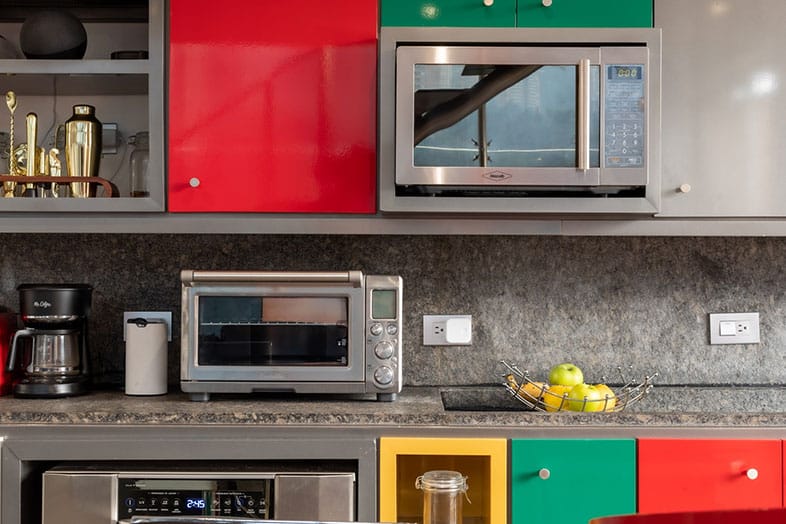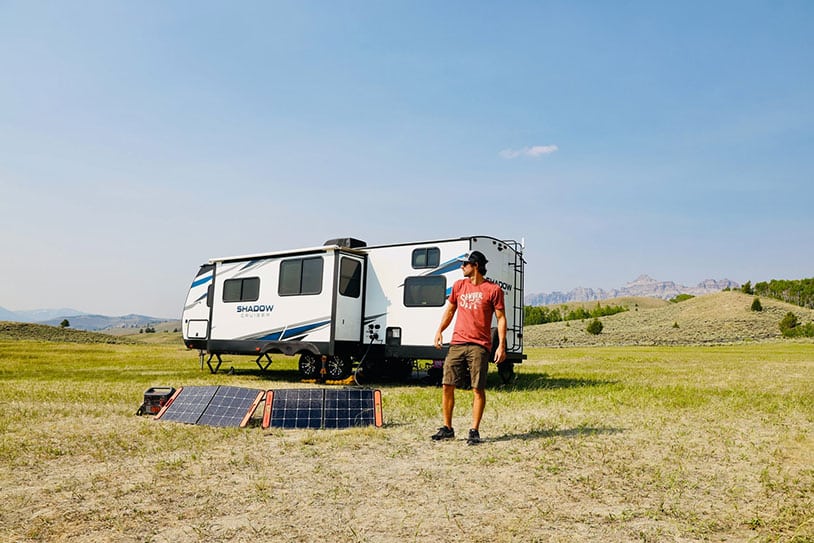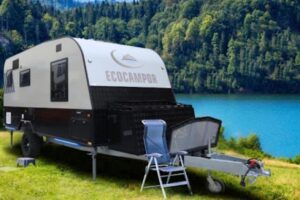RV solar panels
It’s pretty difficult to estimate the average number and size of solar panels needed for any given RV.
With that said, my very rough estimate for this number would be between one and five, 200-watt solar panels.
A small teardrop trailer could fairly easily get away with one, 200-watt solar panel, while large motorhomes often have five or more 200-watt panels.
When I was an RV technician, converting vans into campervans, we would typically install one or two 200-watt panels on each van. This was assuming that a majority of our clients were mostly using their solar to power overhead lights, charge phones, and computers, and run their cooktop and fridge.
Vans that had more power-consuming appliances would sometimes get more panels, but we would typically accommodate the larger power draw with a more significant battery bank.

Calculating Solar Panel Needs
OK, here we get into the nitty-gritty part of the article.
I’m going to tell you what information you’ll need to know about your own energy consumption and also go over some basic equations to help you determine how many solar panels you will need for your RV. There will be math here, but it’s not too bad once you understand the basic concepts, so stick with me.
Power Consumption
The easiest way to determine your daily power consumption is by performing a test while camping.
To do this, you’ll want to make sure all your RV batteries are fully charged and then head out to your favorite boondocking location. In order to perform this test accurately, you’ll need to stay disconnected from shore power for the entirety of the camping trip.
Using a battery monitor*, track the number of amp-hours of energy you use in one day (a full 24 hour period). You will have different power consumption every day, so I suggest doing this test several times and finding the average amount of amp-hours per day you consume. This will result in a more accurate understanding of your power consumption.
Once you know how many amp-hours you consume each day, multiply that number by the voltage of your batteries. Typically lead-acid batteries are 12.6 volts and lithium batteries are 13 volts.
So if you have a lithium battery and you on average consume 90 amp-hours over a 24 hour period, multiply 90 amp-hours by 13 volts to determine that you consume 1,170 watt-hours per day.
*A battery monitor is a clever device that monitors and displays battery voltage, battery temperature, and energy consumption among other things.
Solar Output
Now that you know your power consumption, all you need to know is the average output of your solar panels to figure out how many panels are needed to maintain your RV’s power system.
It is the general consensus that a 100-watt solar panel can produce about 300 watt-hours of energy each day. This is assuming an average of around 6 peak sun hours each day.
A peak sun hour is any hour during the day that one square meter of the earth is receiving 1,000 watts of energy from the sun.

Finally, to calculate how many panels you will need for your RV, simply divide your daily power consumption by the average solar output of your panels. So for our example, we would divide 1,170 watt-hours by 300 watt-hours of output.
1,170/300 = 3.9
Bingo! Just round the number up so that you overcompensate instead of an underestimate, and you now know that you’ll be needing four, 100-watt solar panels to maintain your power system.
Calculators
If you don’t feel like doing all of that math, there is an abundance of online calculators designed to help you determine your solar panel needs.
You will still need to know some of the basic information about your systems, such as power consumption and panel output, but these calculators can be a reliable way to determine your needs if you don’t trust your math skills.
Appliance Usage
Oftentimes people ask how many of their appliances can be used at one time when they are charging their RV using solar. While the size of your solar system will play a role in this, another significant determining factor will be the size and capacity of your battery bank.
RV batteries have a discharge threshold. If you discharge past the discharge threshold for your specific type of battery, you risk damaging the battery and ending up in a situation where your camper has no power.
For lead-acid batteries, the discharge threshold is 50%. This means that you can only use half of the total power stored in your batteries before risking irreversible damage to the battery.
Lithium batteries, on the other hand, can theoretically be discharged 100% without incurring damage. But I would avoid doing this if you can. It’s not a good practice to rely on fully draining your battery bank when you use it, and it’s a pretty quick way to accidentally end up in a “dead in the water” situation.
“Dead in the water” means you have drained both your cranking battery (the one that starts and runs your RV engine), and your auxiliary battery bank. Luckily, you’ll just have to wait for your solar system to recharge everything, but this has the potential to take a long time depending upon weather conditions or time of day.
If you have accurately calculated the number of solar panels needed to support your power system, you should be able to run all of your appliances during peak sun hours without draining your batteries.
But weather patterns can be fickle, and you likely won’t be encountering prime conditions very often. So keep an eye on the charge of your batteries as you run all of your appliances and try not to drain too low.
Alternative Methods
Every single day advancements are being made in the realm of solar power. This is a fantastic trend because, in the opinion of this author, our planet is in desperate need of more renewable energy sources. Lucky for us, nothing is more renewable than the endless supply of energy we receive from the sun.
Most of the advancements being made in solar are through research for large solar farms and solar systems for houses.

As a byproduct of this research, the world of portable solar panels and RV solar is benefitting.
These days, RVers have an abundance of options for products they can buy when building a sustainable power system for their rig.
(Psst… in another article I wrote, I talk in detail about some different products that exist to help you keep your batteries charged.)
Portable Solar Units
Some folks who have built their own travel trailers or who have bought a rig without a solar system opt to use a portable solar unit instead of having panels permanently installed.
Sometimes this is to avoid the cost of installation, other times it is due to a lack of space on the roof of the RV.
These portable units are pretty nifty. They are generally comprised of a foldable panel unit, a bundle of wires, and a large battery with integrated outlets and a digital display. To use these solar systems, it’s typically just a matter of setting up the panels in the direction of the sun, plugging them into the battery, and letting the solar magic happen.

Once the battery bank is sufficiently charged, you can use it similarly to how you would use a regular wall outlet. Just plug in your devices and let them charge using sweet, renewable sun juice.
It’s unlikely you will ever be able to use large appliances like air conditioners, furnaces, and cooktops using one of these units. But they are perfect for phones, laptops, headlamps, and other portable electronics. I commonly see van-life digital nomads using these units to keep themselves charged up as they work and adventure.
Solar Gadgets
These days all sorts of electronic devices have compact solar panels built right into the device. I’ve seen fans, lamps, coolers, speakers, and water purifiers that all utilize built-in solar panels to maintain their batteries.
The more RV gear you own and use that has integrated solar, the less strain you will be putting on your own solar system and battery bank.
I know many van-lifers who have solar lamps that they put on the dashboard of their van as they drive around and adventure. Once evening rolls around, they pull the lamps off the dash and hang them up in the interior of their living area, using them to cook, read, and do chores by.
Use Solar!
Solar power is incredible. Honestly, the ability to harness the power of the sun for our own uses… still blows my mind sometimes.
And it’s cheaper than ever! So if you aren’t already utilizing solar in your RV system, I highly suggest it. Of course, there will be some initial investment costs, but I’ve never encountered an RVer who has regretted making that investment in the long run.
The sun is always hanging out up there, waiting for you to take advantage of its infinite power… so just do it!



